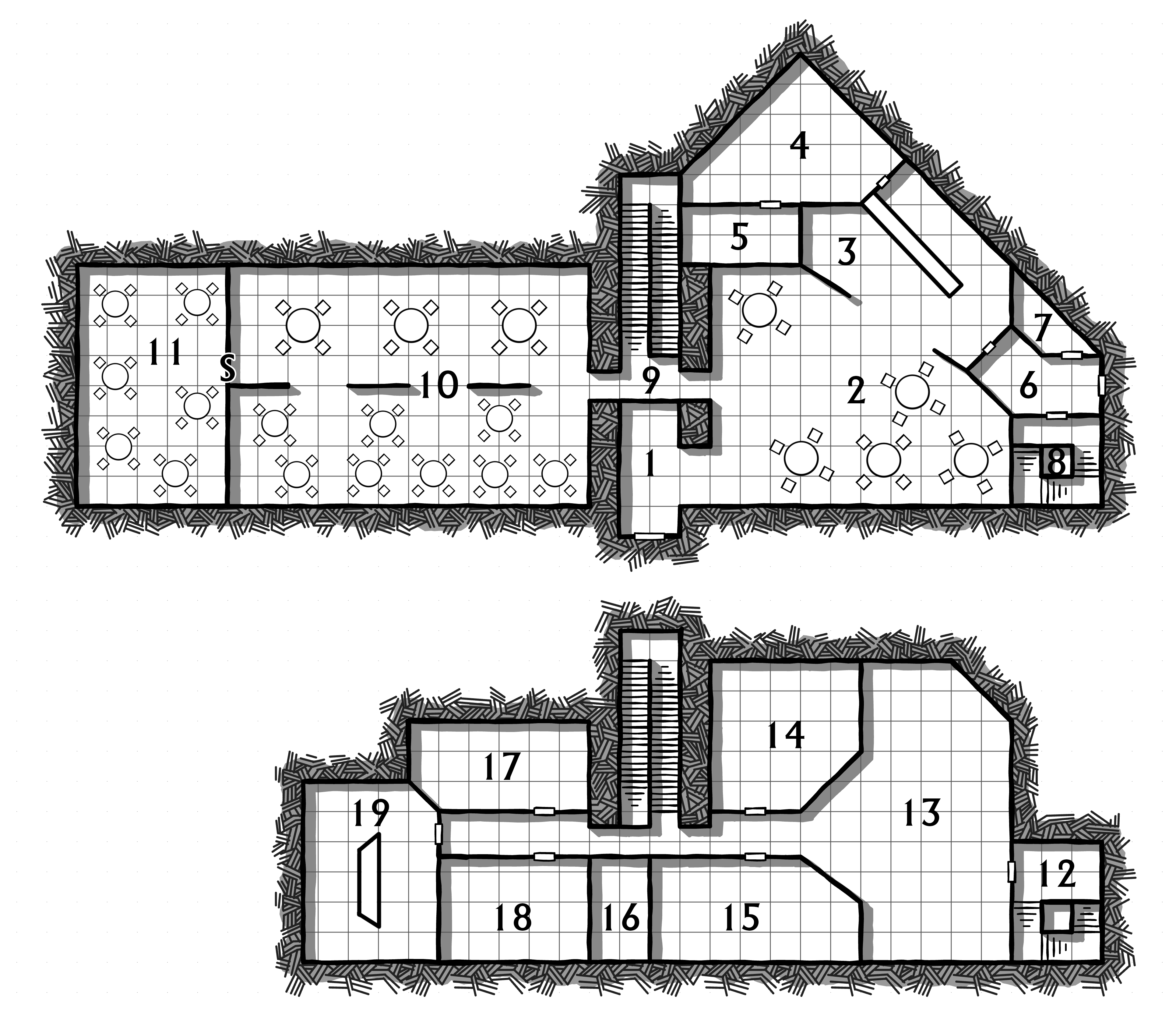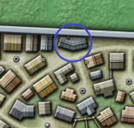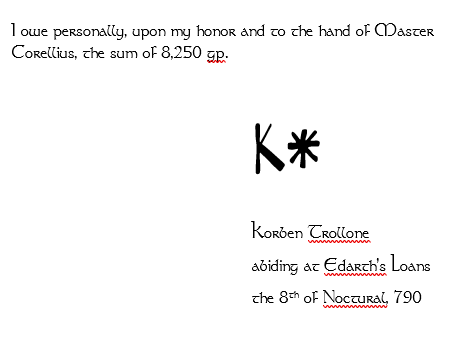Every new RPG unlocks new and exciting experiences! ENnie Award-winning RPG designer Justin Alexander guides you through the step-by-step process he uses to quickly master a new game so that you can start playing it ASAP!
Advanced Gamemastery: Learning a New RPG
The Vladaam Affair – Part 9: Fleet of Iron Sails
The Vladaams maintain a fleet of trade ships which are active throughout the Whitewind Sea. They are notable for their dull grey sails. The current Fleet of the Iron Sails consists of eighteen ships.
Note that all ship captains of the Fleet of Iron Sails are members of the Brotherhood of Yrkyth. (See Part 14: Guild – Surveyor’s Headquarters.)
FLEET OF IRON SAILS
- Dragon’s Wake – Admiral Vorray
- Shark’s Tail – Captain Radgha
- Island’s Barnacle – Captain Sycol
- Pride of Morrain – Captain Boastia*
- Gods’ Pearl – Captain Hinmos
- League of the East – Captain Rilundi
- Joyful Mermaid – Captain Chever
- Prince’s Servant – Captain Therech
- Eye of the East – Captain Morsul*
- Honest Sailor – Captain Perot
- Navigator’s Hope – Captain Kuish
- Rhapsody – Captain Kelhin
- Myliesha’s Sail – Captain Croitka*
- Southern Majesty – Captain Nisshin
- Southern Jewel – Captain Woryss
- Teeth’s Trust – Captain Erdrae
- Thunder’s Wave – Captain Louzab
- Storm’s Blessing – Captain Ennia
CREW
These ships have a captain, 2d8 x 3 sailors, 1d6-2 Vladaam Guards, and a 25% chance of 1d2 Vladaam Advanced Guards (possibly serving as first mate).
Particularly valuable cargos may have a special platoon consisting of Advanced Guards and a Vladaam Mage.
Sailors: Use commoner stats, MM p. 345. Proficiency in Athletics, Perception, Navigator’s tools, vehicles (water).
Vladaam Guards: Use guard stats, MM p. 347, with AC 17. (Equipment: breastplate, shield, longsword, longbow, arrows x20, potion of healing, Vladaam deot ring.)
Advanced Vladaam Guards: Use knight stats, MM p. 347.
SCHEDULE
At any given time, 1d6-3 of these ships will be docked at Ptolus. (Determine which ships randomly.)
Most of the Fleet engages primarily in honest trade, while only occasionally carrying a cargo of smuggled goods or drugs.
CARGO: Each ship generally carries 2d4 loads of goods. There is a 10% chance that 1d3 loads are Illicit Goods. For all other loads, roll on the Trade Goods table below.
*SLAVE SHIPS: The Pride of Morrain, Eye of the East, and Myliesha’s Sail are regularly used to transport slaves for the Ennin, collecting them from islands in the Whitewind Sea and delivering them to the Ennin Headquarters (Ptolus, p. 168). These ships have a 50% chance of carrying a cargo of slaves. Otherwise, they’re currently carrying normal goods. (See Part 16: Slave Trade.)
TRADE GOODS
d30 Trade Good
1 Beer
2 Wine
3 Textiles (linen, wool, hides, furs, leathers)
4 Clothing
5 Smoked Meat
6 Dried Fruit
7 Grain (rice, wheat, barley, oats)
8 Salt
9 Exotic Spices (cinnamon, ginger, pepper)
10 Wickerwork
11 Common Metals (iron, copper)
12 Precious Metals (silver, gold)
13 Very Precious Metals (platinum)
14 Perfume
15 Bronzework
16 Quality Stone
17 Glass
18 Incense
19 Dye
20 Tobacco
21 Timber
22 Oil
23 Ivory/Ivoryworks
24 Tools
25 Weapons/Armor
26 Pottery
27 Livestock (pigs, sheep, goats, cows)
28 Furniture
29 Silk
30 Magic Items
ILLICIT GOODS
d6 Illicit Good
1-2 Snakeweed / Abyss Dust (from Freeport, see Part 18: Drug Running)
3 Alchemical Supplies (shipping to random alchemy lab, see Part 7)
4 Magic Items
5 Wildlife (possibly shipping to Korben Trollone)
6 Normal Trade Good (avoiding the tariff)
Advanced Gamemastery: Describing the World
The GM’s words are the players’ window into the game world. ENnie Award-winning RPG designer Justin Alexander reveals the simple techniques you can use to improvise descriptions and immerse your players in your game.
The Vladaam Affair – Part 8C: Curse Den – Rivergate District

Staff Location
Vladaam Guard Area 1
1d3 Hostesses + Bartender Area 2/3
Peacock (Vladaam Advanced Guard) Area 3
Cook Area 4
Vladaam Advanced Guard Area 6
Vladaam Advanced Guard Area 9
1d4 Hostesses Area 10
2 Hostesses Area 11
Vladaam Mage + Journeyman Alchemist Area 14 (75%)
Den Master Corellius1 Area 14 (75%)
1d3 Hostesses Each room on 2nd Floor
2 Vladaam Guards Patrolling 2nd Floor
1 Carries key for the safe in Area 14.

Curse Den – Rivergate
Outer Ring Row – E2
AREA 1 – ENTRANCE
Stairs of blue marble lead through doors ornately carved in a yin-yang composition of a dragon and unicorn pursuing each other.
AREA 2 – SALOON
A cluttering of chairs around a handful of low tables. The warm, dark glow of polished mahogany gleaming from every surface.
TO AREA 10: A bouncer stand guard at the archway leading to the short hall past Area 9: The Main Stairs or into Area 10: Snakeweed Lounge. Passing requires approval and the payment of a 10 gp cover. (Or no approval and a large bribe.)
AREA 3 – BAR
A well-stocked bar, mostly focused on ales.
THE PEACOCK: A pet peacock roosts on the bar here. It spreads its tail in a beautiful display whenever someone tips.
The peacock is actually a Vladaam agent who has been polymorphed. In this form, the agent can eavesdrop surreptitiously on conversations, gleaning potentially valuable intel from bar chatter.
AREA 4 – KITCHEN
A well-stocked kitchen.
AREA 5 – FOOD & LIQUOR STORAGE
Pretty much what it says on the tin.
AREA 6 – REAR ENTRANCE
The rear entrance is primarily used by those interested in the more exclusive upstairs lounges. It also allows access to the curse den “after hours.” It requires a password or a 100 gp fee.
AREA 7 – DRUG STORAGE
REINFORCED DOOR: AC 19, 300 hp, DC 25 Dexterity (Thieves’ Tools)
Neatly organized in small wooden boxes on shelves:
- 15,000 doses of snakeweed
- 5,000 doses of shivvel
- 75 doses of agony
AREA 8 – REAR STAIRS
These stairs go up to Area 12. They’re used by staff and the “rear entrance” clientele (see Area 6).
AREA 9 – MAIN STAIRS
The walls of the main stairs have a marvelous set of Ascent of Dragons murals. (Similar to the “Ascent of Man,” but showing a red dragon progressing from a wyrmling to an ancient dragon atop his treasure horde.) The final image of the treasure horde is on the wall opposite the top of the stairs in Area 17.
DC 18 INTELLIGENCE (INVESTIGATION): There are a pair of small amethysts set into the stairs about halfway up. These are the focal points for a pair of alarm spells that are activated after hours. (Audible alarm. Cast at a higher level in order to increase its volume.)
AREA 10 – THE SNAKEWEED LOUNGE
Filled with snakeweed smoke. A number of magical, ceramic sculptures resembling slowly writhing masses of tentacles also a serve as standing hookahs from which anyone can take a hit of snakeweed smoke.
SKULLRATTLE: The tables in the northern chamber are set up with several low-stake skullrattle games using a variety of young dragon skulls.
BETRANT TABLES: The tables in the southern chamber host low-stakes bertrant games.
SECRET DOOR: DC 12 Intelligence (Investigation). A simple secret door spins around to grant access to the high-stakes bertrant tables. (Any observation of the chamber during business hours will notice hostesses and high-roller coming and going through this door.)
AREA 11 – HIGH-STAKES BERTRANT
These are all high-stakes bertrant games. Minimum bets at most tables are 100 gp, but there’s also a 1,000 gp bet table.
AGONY HOSTESSES: Agony is available for sale in this room. Hostesses carry 1d6 doses each.
AREA 12 – STAIN-GLASSED WINDOW
The window at the top of the rear stairs is a beautiful piece of stained glass depicting a black dragon. A plaque beneath the window reads, “THE WYRM ORACTHON.”

AREA 13 – SHIVVEL LOUNGE
A number of comfortable chairs where shivvel smokers congregate.
AREA 14 – CURSE JEWEL WORKSHOP
DOOR: Oak-veneer over iron core. AC 19, 300 hp, DC 24 Dexterity (Thieves’ Tools)
WINDOW: The window is made of diamond crystal. AC 19, 300 hp.
A desk of dark-stained oak is positioned near the center of the room with a chair angled to look out the window. A workshop for creating magical items is arrayed around the perimeter of the room.
DESK: Includes Report on the Debts of Dilar. (The “CS” referred to in the letter is Celadore Silverwood of Dark Leaf. The Runshallot warehouse is the Vladaam’s slave trade warehouse, see Part 16: Slave Trade.
WORKSHOP: Includes Instructions for Creating Curse Jewels and a set of jeweler’s tools.
- DC 15 Intelligence (Arcana): Provide players with the properties of a curse jewel.
HIDDEN SAFE: Located in the floor. DC 22 Intelligence (Investigation), DC 30 Dexterity (Thieves’ Tools).
- 15d10 x 10 platinum pieces, mostly in gold and silver coins.
- IOU from Korben Trollone.
IRON COFFER (10% chance): If present, contains 500 gp, 40,000 sp, and 50,000 cp with instructions to have the Ithildin couriers ship it to the Red Company of Goldsmiths on Gold Street.
AREA 15 – CURSE JEWEL LOUNGE
A richly-accoutered lounge, with rounded divans of red velvet circling a central area raised in a dais. A bulging aumbry with dragon’s claw feet stands against one wall.
AUMBRY: Contains 10 doses of agony, 40 doses of abyss dust, and 4 curse jewels.
SECRET DOOR: DC 18 Intelligence (Investigation).
DAIS: DC 20 Intelligence (Investigation) to discover a secret compartment in the dais. Pushing a concealed button causes a panel to slide aside and a curse globe to rise into view.
DM Background: This room is rented by individuals or small groups. Slaves are led in from Area 16 and curse jewels are used on them.
AREA 16 – SLAVE CHAMBERS
This room has a permanent silence spell cast on it. It contains 1d4+1 slaves, usually beautiful young women.
SLAVES: These slaves were originally brought to Ptolus aboard the Sarathyn’s Sail (see Part 9: Fleet of Iron Sails) and then sold through the Ennin slave market (Ptolus, p. 399).
AREA 17 – DRAGONSCALES TABLE
Three tables, each set up with a set of dragonscales tiles.
DRAGONSCALES: All three tables have gold dragonscales sets. A trained eye can price two of the sets at 1,500 gp each. At a casual glance, the third set is just as nice, but is actually slightly cheaper in its craftsmanship (and is only worth 250 gp).
- The cheaper dragonscales set has the word “Yarrow” carved into the edge of its board.
- DM Background: A dragonscales set was stolen from this curse den several months ago. It was replaced with a set from the Oldtown curse den (on Yarrow Street) until a permanent replacement set is procured.
DM Background: This chamber is rarely used, but very exclusive.
AREA 18 – HIGH-STAKES SKULLRATTLE
This table has the skull of an ancient red dragon accoutered for skullrattle. It’s a high-stakes game requiring 500 gp minimum bets. The entire room is under the effects of an antimagic field to prevent magical cheating.
AREA 19 – SNUFF CHAMBER
The mahogany table in the center of this room is equipped with large manacles designed to bind someone firmly to its surface.
AUMBRY: Contains 20 doses of agony, 100 doses of abyss dust, and 12 curse jewels.
TABLE – DC 20 INTELLIGENCE (INVESTIGATION): The table has a hidden compartment where a slave manacled to its surface can be quickly dropped out of sight. (The compartment has a permanent silence spell cast on it.)
DM Background: Groups (or, more rarely, individuals) will employ this room to use curse jewels on a single slave bound to the surface of the table. This often results in the death of the slave and the groups pay extra for their murderous delights. The “ritual” is often accompanied with doses of agony.
This particular snuff chamber is rarely used. Those looking for this sort of “entertainment” are more likely to use the curse den in Oldtown, but the relative privacy and exclusivity attracts a very particular type of client.
HANDOUTS
REPORT ON THE DEBTS OF DILAR
Den Master Corellius—
I understand your concern, but Dilar’s affiliation with the Dark Leaf doesn’t offer him immunity. These debts you’re describing from the Oldtown Curse Den are disturbing and simply cannot be tolerated. In fact, this only contributes to a pattern of irregular behavior which is particularly alarming in light of his duty to provide security at the warehouse on Runshallot.
If you deem it wise, set spies upon him. It’s possible his loyalties have become divided and this matter may give us fair excuse to investigate without raising any possible alarm if other eyes have been placed on him.
In any case, if the matter of the debt is not resolved, you should feel empowered to contact CS directly and resolve it permanently.
Godfred V.
IOU FROM KORBEN TROLLONE
Review: Night’s Black Agents – The Persephone Extraction
At the moment, there are three major published campaigns for Night’s Black Agents. I’ve previously reviewed The Zalozhniy Quartet, and The Dracula Dossier is a beast still awaiting its time in the sun for me. (If you’ll forgive either the least or the most appropriate metaphor of all time). So today let’s take a peek at The Persephone Extraction.
At first glance, this looks like an adventure anthology: Five adventures. Five authors (each presumably writing one of the scenarios). And, in its first paragraph, the book does kind of limply wave its hand in the direction of “they can be played individually.”
In reality, however, this is definitely a mini-campaign. In fact, it’s virtually impossible to imagine running this in any other way: The continuity between the scenarios is tightly woven and all of them are pretty immutably bound to the specific vampiric mythology of the campaign.
STRUCTURAL ISSUES
The Persephone Extraction is also pretty wedded to the idea that you can play most of its scenarios, after the introductory scenario, in any order. Which is good in theory, but in practice you can’t have a big finale adventure with a bunch of continuity dependent on the PCs’ having played the other scenarios in a wide-open node structure where the PCs could head to the finale at literally any time.
Well… you can. It just won’t end well.
(Pun intended.)
With that being said, The Persephone Extraction repeats the gimmick from The Zalozhniy Quartet where the clues pointing to other scenarios are listed in the “Aftermath” section at the end of the scenario, instead of being mentioned in the locations where the clues would actually be discovered. So the idea may be less that the players are free to pursue the scenarios in any order, and more that the GM is free to choose the order in which they will be played and can choose which clues to seed into each scenario to force that to happen. (Which is such an anathema to me, that it’s difficult to understand why anyone would want such a functionality, but maybe they exist.)
Either way, I’m fairly certain the number of GMs who will get to the end of one of these scenarios and go, “Crap. I forgot to include the clues they need for the next scenario,” will be non-zero. It’s just such an unfriendly way of organizing material for actual play.
On a similar “unfriendly for actual play” note, some of the authors also have a deep desire to title every scene as if it were a short story:
- When the Wind Blows
- The Thin Red Line
- Guerilla Gardening
- Going Viral
- City on the Edge of Nowhere
I get the impulse, because they sound cool and feel evocative. In practice, sadly, it just makes it incredibly tough to simply flip through the book and find what you’re looking for.
CONSPYRAMID & VAMPYRAMID
The fact that the book is titling individual scenes has probably also made you suspicious that they’re once again prepping plot instead of Conspyramid nodes. This is, unfortunately, true. Unlike The Zalozhniy Quartet, however, The Persephone Extraction does include a Conspyramid.
If you’re not familiar with the concept, Night’s Black Agents features a campaign structure called the Conspyramid. It consists of various nodes — the cults, front companies, sources of blood, and other infrastructure of the vampire conspiracy — arranged into a pyramid diagram and connected to each other. The result is a model of the conspiracy that the PCs can navigate through using both clues from their investigations and the games’ proactive investigation mechanics.
The Conspyramid in your Night’s Black Agents campaign, therefore, is also the structure of play.
The Conspyramid in The Persephone Extraction, on the other hand, is largely incoherent because it’s so utterly divorced from the tightly-plotted, linear scenarios that fill the rest of the book and are the actual structure of play. This actual structure of play is perhaps better represented by the “scene flow diagrams” that are jammed in at the back of the book, although only somewhat.
Of far more use, however, is The Persephone Extraction’s custom Vampyramid.
The Vampyramid in Night’s Black Agents is a parallel structure to the Conspyramids and is basically a system for managing the conspiracy’s reactions to the PCs’ actions. Unlike the Conspyramid, which is unique for each campaign, the core rulebook includes a standard Vampyramid that can be used in every campaign. The Persephone Extraction, however, eschews the standard Vampyramid, and instead offers a heavily customized version for use with the adventures in the book.
This is really cool tech: It’s a cool enhancement for this campaign specifically, and it’s a great model for doing the same thing in your other Night’s Black Agents campaigns.
(The only quibble being that the Vampyramid is designed to be used in conjunction with a fully functional Conspyramid, and since The Persephone Extraction isn’t actually structured around the Conspyramid, you can’t actually use the Vampyramid procedures. Whoopsie. But the material is nonetheless useful, even if you’re going to have to improvise a bit to make it work.)
SPOILER WARNING
Let’s lay all these structural problems aside and assume that you’re just going to run The Persephone Extraction as the lightly branch-plotted experience it’s primarily designed to be.
What is this campaign, exactly?
We’ll be revealing some spoilers here. Proceed at your own risk, wanderer!
THE SPIRITS OF HADES
The vampires of The Persephone Extraction are Orphic in nature: The Greek legends of Hades reflect a dark truth and the tale of Orpheus, in particular, is the refracted memory of a vampire origin story. A mortal descends into a strange realm filled with the souls of the dead, and as they return one of those souls follows them out. One might even say that the dead was shadowing them… literally, because that dead spirit was hidden within their shadow.
Destroyed by the sun, just like any vampire of the non-glittery variety, these undead spirits can become bound to the shadows of their hosts as companion spirits and thus escape their purgatory. Nonetheless, they remain terribly diminished, little more than a memory of their mortal selves; reduced physically to a vaporous spirit and even mentally to an often confused and dazed state.
… until blood is spilt near them.
From the lifeblood of mortals, the vampiric spirit can draw strength. The more blood spilt, the more powerful it becomes. Powerful enough to escape its host shadow. Powerful enough to taste life again. Powerful enough to forge a global conspiracy to ensure that the blood will always flow.
The classical, Greco-Roman mythological inspiration for these vampires is basically straight up my alley. I love everything about them: I love how you can pull source material from mythologies across the globe, give it a twist, and end up with a new scenario. I love that they feel utterly alien to what we think of when somebody says “vampire,” but are nonetheless so firmly rooted in vampiric traditions as to leave no doubt to their right to bear the name. I love how the mythology provides an easy mechanism for ramping up threat and difficulty (increase the available blood = increase the difficulty of the vampire). I love that it takes what we know about history and mythology and warps it through a lens of “truth” that leaves your faith in reality deeply shaken.
These vampires are so cool, they almost sell The Persephone Extraction all by themselves.
I do, unfortunately, have to ruin things with a few more quibbles.
First, the mechanical implication of the concept – which features a triptych of bulky stat blocks – feels pretty clunky and very finicky. But, to be fair, I have not actually run a game with these stat blocks, so perhaps they work better in actual practice than it would seem.
More problematic, in my opinion, is that the handling of the vampiric metaphysics in The Persephone Extraction is pretty sloppy. For example: What can a vampire do while it’s hiding in its host’s shadow? Depending on the adventure, the answer seems to vary from complete impotence to a poorly defined grab bag of supernatural chicanery.
I suspect the problem here boils down to the multiple writers working on the book. I’m only assuming that each of them worked on a separate scenario, but it would neatly explain these inconsistencies. (Of course, that doesn’t mean you won’t have to figure out how to fix things up at your own table.)
THE PALE AGENDA
The vampires atop the conspiracy move at a different pace from the modern world: They sleep long and awaken rarely, leaving their day-to-day affairs in the hands of their philomeli; their hosts. As technology and communication have sped up, the ancient spirits become more disoriented and confused. Some have withdrawn into permanent torpor.
Others, however, have concluded that the herd is out of control and it’s time for a culling.
To this end the conspiracy has spent several years experimenting with the Marsburg virus, creating the experimental MAR-VX variant. This is the apocalypse in a bottle, capable of wiping out 99% of the human race and returning the population base to a level that the vampires feel they will be able to control.
This is known as the Pale Agenda. Originally initiated as a safety contingency, part of the conspiracy has decided it’s time to put the plan into motion. This has created a schism, however, between the Loyalists (“we do whatever our lords and ladies tell us to do”) and the Dissidents (“we like being rich and powerful, and our money and our power depends on modern civilization existing”). This division within the conspiracy creates a lovely dynamic, which is reflected in both the scenario design as well as the variant Vampyramid.
The Pale Agenda is, obviously, horrific almost beyond the scope of imagination. It’s a great way of cranking up the campaign stakes: It’s not just a vampiric conspiracy you’re struggling against; it’s the literal end of the world.
The only drawback, unfortunately, is that the continuity is, once again, a little sloppy.
For example, in the opening scenario the Loyalists frame the PCs for destroying the MAR-VX virus and all the research that would allow the conspiracy to recreate it. Which kinda undermines the campaign stakes I was just lauding, but then there’s a scenario where the PCs have to stop the vampires from getting their hands on a sample of the MAR-V virus that the MAR-VX virus was based on. (But I thought all the research showing how to turn MAR-V into MAR-VX was destroyed?) And then later none of that actually matters, because in the final scenario “the last surviving canister of augmented MAR-VX” just shows up no matter what the PCs have done.
THE SLOW DECAY
I read The Zalozhniy Quartet and The Persephone Extraction back-to-back to see which campaign I would be running this summer.
For the first half of the book, I was terribly excited about The Persephone Extraction and it was easily outpacing the Quartet: The overall design was far stronger and more coherent. The concept for its vampires electrifyingly original. The scenarios interesting and varied.
In the back half of The Persephone Extraction, unfortunately, the promise of the pomegranate blossom wilted pretty fast. As the campaign moves forward, both the mythology and the logistics of the conspiracy seem to melt down into an inchoate mess.
Some of this is the result of the myriad continuity errors we’ve already discussed, but another factor seems to be the designers’ desire to prep heaping mounds of contingencies on top of a vaguely defined mythology.
The failure to achieve a coherent metaphysic for the mythology is perhaps best exemplified in the second-to-last scenario, which is designed to allow the PCs to pass through a gate and into the Underworld from which the vampiric spirits come. This Orphic journey is insanely ambitious and the excitement I experienced in reading the initial pitch for this scenario was immense. Unfortunately, the book just can’t nail down what’s actually happening to the PCs and, like the dog who’s just caught a car and has just realized that they don’t know what happens next, the designer seems to have no idea how to actually realize the epic scope of what they’re grasping for, and so we end up with a weird railroad built on top of amorphous geography.
Contingency-based-prep, on the other hand, is when you “try to second-guess your players and develop mutually contradictory material for every possible choice they might make.” The Persephone Extraction’s plot-based prep combined with the directive that the scenarios should be playable “in any order” (or skipped entirely) unfortunately takes the perfectly legitimate desire to have the PCs’ actions in the previous scenarios impact the final scenario and makes it cancerous.
They still might have pulled off this nigh-impossible juggling act if they weren’t balancing on the house of cards formed from their ill-defined mythology. The result is a final scenario that just doesn’t really make much sense: Baffling stuff just sort of arbitrarily happens while the GM is awkwardly shoving the PCs around. This becomes a feedback loop, because the less stuff makes sense, the more confused the players will become, and the more the GM will need to shove them into situations they don’t (and can’t) understand.
Sadly, despite so much of this confusion being in service of “making the PCs’ actions matter,” the designers — trapped in their plot-based prep — ultimately can’t even deliver on that promise (as evidenced by the aforementioned canister of MAR-VX that materializes out of thin air because the plot requires it).
So, ultimately, we are left with the incredible concepts at the heart of the campaign and the very strong opening giving way to a disappointing finale, with my own opinion slipping from “must run ASAP” to “maybe I’ll fix this some day.”
Hopefully this review has captured this dichotomy — not only reflecting my ultimate disappointment, but also my excitement at The Persephone Extraction’s very real strengths.
In the end, I give The Persephone Extraction a cautious recommendation. But my own decision, ultimately, was to run The Zalozhniy Quartet, and that’s also what I’d recommend to anyone else trying to figure out which Night’s Black Agents mini-campaign they should check out first.
Grade: C+
Story Design: Gareth Ryder-Hanrahan
Designers: Heather Albano, Gareth Ryder-Hanrahan, Emma Marlow, Will Plant, Bill White
Publisher: Pelgrane Press
Cost: $29.99
Page Count: 160
Archives
Recent Posts
- Ex-RPGNet Review: The Malady of Kings
- Advanced Gamemastery: How to Run Horror RPGs
- The Vladaam Affair – Part 16E: Slave Trade Handouts
- Ex-RPGNet Review: A Lion in the Ropes
- Ptolus: Running the Campaign – Contract Handouts
Recent Comments
- on Ptolus: Running the Campaign – The Undead Sequel
- on Review: Heroes of the Borderlands (D&D Starter Set 2025)
- on Review: Heroes of the Borderlands (D&D Starter Set 2025)
- on Thought of the Day: Elven Teeth
- on In the Shadow of the Spire – Session 48A: A Night in the Necropolis
- on The Art of the Key – Part 4: Adversary Rosters
- on Random GM Tip – Running Background Adventures
- on In the Shadow of the Spire – Session 47C: Home Suite Home
- on The Secret Life of Nodes – Part 5: Naturalistic Node Design
- on Review: The Shattered Obelisk













